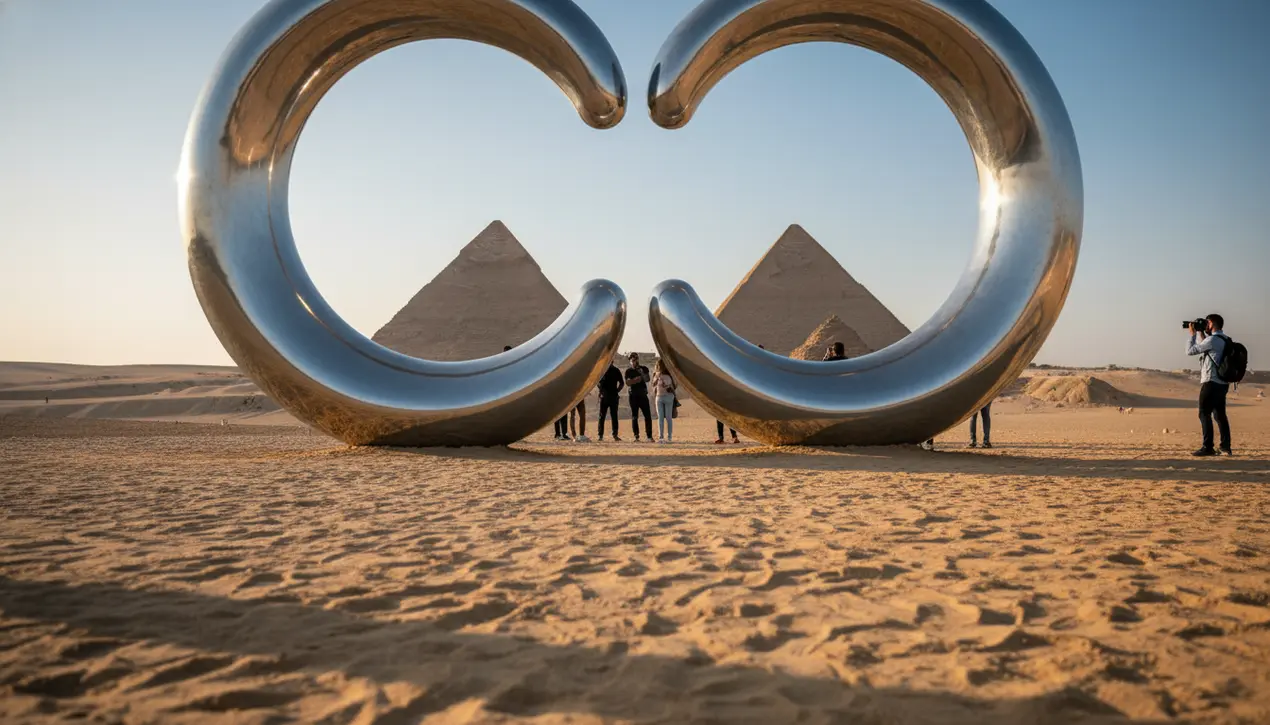
Entertainmenttheatre & artsArt Exhibitions
Reflective aluminum sculpture splits apart to frame Giza pyramids.
SO
Sophia King
2 hours ago7 min read1 comments
In the vast, sun-baked expanse overlooking the Giza plateau, a new kind of artifact has emerged, not from the ancient world but from a contemporary vision that speaks its language. Turkish artist Mert Ege Köse has installed a monumental, reflective aluminum sculpture that performs a delicate dance with history, its two curved halves deliberately split apart to create a perfect viewfinder for the timeless pyramids.This is not merely an object placed in a landscape; it is an interactive frame, a portal that recontextualizes one of humanity's most iconic achievements. The work is a modern reinterpretation of the shen ring, an ancient Egyptian symbol of eternity, completeness, and divine protection, often depicted in hieroglyphics as a loop of rope.Where the original was a simple circle, Köse’s version is a volume defined by mathematically calibrated curves, a form that feels both ancient and futuristic. Its highly polished, mirror-like surface is the key to its magic.It doesn’t just sit in the environment; it actively engages with it, reflecting the vast, shifting hues of the Egyptian sky, the golden sands, and the stoic presence of the pyramids themselves. The sculpture becomes a living canvas, its appearance changing with the time of day, from the soft blush of dawn to the intense, fiery orange of sunset, effectively painting a new picture of the ancient site every hour.This interplay between the static, millennia-old stone structures and the dynamic, ephemeral reflections on the aluminum creates a powerful dialogue about time and permanence. It forces the viewer to see the familiar in an entirely new light, quite literally.The act of framing—of using the split in the sculpture to precisely compose a view of the pyramids—is a deeply human one, reminiscent of how we use our phone cameras, but here it is elevated to a ceremonial act. It makes the viewer a participant in the artwork, an active agent in connecting the symbolic language of the past with the aesthetic sensibilities of the present.Köse’s work is part of a growing movement where artists are using advanced digital design and fabrication tools not to create cold, impersonal objects, but to produce works that are deeply resonant and human-centric. The mathematical precision of the curves is not an end in itself; it is a means to achieve a form that feels inherently right, that echoes the sacred geometry often associated with ancient Egyptian architecture.This project, presented as part of the ART D'EGYPTE initiative, highlights how contemporary art can serve as a bridge, using the visual vocabulary of technology to explore and honor spiritual and historical concepts. It asks us to consider what eternity looks like in the 21st century. Is it the unchanging stone of the pyramids, or is it the fleeting, perfect moment captured in a reflection, a moment that is unique and will never be replicated? The sculpture offers no easy answers, but in its silent, gleaming presence, it provides a space for that profound question to be contemplated, proving that the most powerful tools for a creative today are not just software and metal, but vision, context, and a deep respect for the echoes of history.
#featured
#Mert Ege Köse
#sculpture
#Giza Pyramids
#Shen Ring
#reflective aluminum
#contemporary art
#installation
Stay Informed. Act Smarter.
Get weekly highlights, major headlines, and expert insights — then put your knowledge to work in our live prediction markets.
Comments
Loading comments...
© 2025 Outpoll Service LTD. All rights reserved.